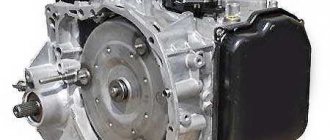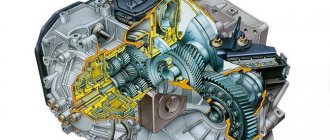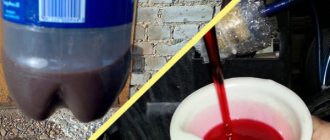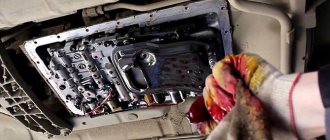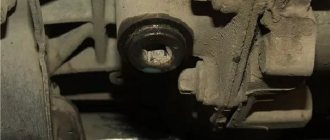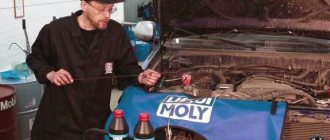There are a huge number of transmissions in the automotive world. There are robotic gearboxes, tiptronic, variator, etc. But still the most popular are manual and automatic. And if there are no problems with servicing the first one, then nuances arise with the automatic transmission. This box has a different operating principle and design, and therefore you need to know how to properly care for it. One of the necessary operations is replacing the ATP fluid. This can be a complete or partial oil change in the automatic transmission. What's better? The expert’s opinion and features of the work are further in our article.
Why is replacement needed?
If you refer to the operating instructions, you can read the following information that ATP fluid is filled for the entire service life of the automatic transmission. But this is only possible if the car is used for no more than five years or 120 thousand kilometers, as is the case in Western European countries. In Russia, the realities are somewhat different. There are many examples when cars with automatic transmission are used for 400, 500 thousand kilometers. Of course, no oil can withstand such a period. It is a consumable item and therefore must be replaced periodically.
The fact is that the oil in the automatic transmission plays the role of a working fluid. It not only lubricates the box parts, but also circulates through the valve body channels under pressure, and also provides a wet clutch in the torque converter. Due to high loads, over time the oil loses its properties.
Overheating is especially dangerous for liquids. If slippage has been observed or there are problems with the cooling system, the oil becomes dark in color. It may also have a characteristic burning smell. Therefore, if replacement is not made in time, some parts will run dry, which significantly reduces their service life.
Change of oil
Changing the oil in an automatic transmission is very different from the same process, but carried out in a manual transmission: it is impossible to drain the entire volume of lubricating fluid. Most of the residue is inside the donut, a smaller part in the hydraulic plate and actuators. Therefore, the following types of oil changes are used:
- partial (incomplete);
- double partial;
- full (hardware).
If partial, drain about half of the liquid, then add new liquid to the required level. The double method consists of first performing a partial fluid change, then starting the engine for a short time to allow the lubricant to mix, and performing another partial replacement. This method manages to replace approximately 70% of the liquid.
Changing the oil in an automatic transmission
The hardware method allows you to replace 95–98% of the transmission, but it requires serious intervention in the automatic transmission oil system and double, and often even triple the volume of new oil.
Partial replacement
This operation is basic because it includes all the basic actions:
- draining transmission fluid;
- filter replacement;
- cleaning the tray;
- filling oil;
- adjusting the transmission fluid level.
These steps are called basic because they have to be performed with any oil change method.
Here are the equipment and tools you will need to complete this operation:
- a garage with a pit, overpass or lift;
- a set of open-end and socket wrenches;
- Screwdriver Set;
- pliers;
- container for draining waste;
- a syringe or system for filling new liquid (must be selected according to the box or car).
Filling system VAS 6262
This tool and equipment are necessary to work with any automatic transmission.
Procedure
To carry out this procedure, proceed as follows:
- Place the machine on a pit, overpass or lift and support it with wheel chocks.
- Disconnect the battery to protect the engine ECU and gearbox; on some cars it is better to remove it, this will make it easier to access the upper part of the automatic transmission.
- Give access to the transmission from the hood side; this is only necessary in cases where, for some reason, it is more convenient for you to fill the oil from above, for example, through the breather hole.
- Remove the automatic transmission protection; it can be made either in one sheet with the engine protection, or stand separately.
- Place the container and unscrew the drain plug; on some transmissions you will also have to unscrew the measuring tube; without this, you will not be able to drain the oil.
- When the fluid runs out, remove the pan to gain access to the filter and hydraulic plate.
- Change the internal filter. Despite the fact that some experts recommend washing it, we advise changing it, because the cost of a new element cannot be compared with the damage that a washed filter can cause.
- Replace the external filter if your transmission has one (if it is not, we recommend installing it, this will extend the life of the automatic transmission).
- Replace the gasket and replace the pan. Some automakers, for example, BMW, do not sell the gasket separately, only together with the pan and new fasteners. Therefore, it is up to you to decide whether to take a substitute, that is, a non-original gasket of unknown quality, or to install what the manufacturer offers.
- Screw in the drain plug; if the box is equipped with a measuring pipe, screw that in first.
- Fill the oil to the required level. The method for checking and adjusting the amount of lubricant depends on the design of the box.
- Reinstall and connect the battery.
- Start the engine and check the level again; this operation is performed differently, depending on the design of the automatic transmission.
Partial oil change in automatic transmission
Reinstall the removed parts.
Double partial replacement
Perform such an oil change in the automatic transmission according to the algorithm described above. Only after the first replacement, start the engine and let it run for 5–10 minutes so that all the fluid in the automatic transmission is mixed, and also switch the selector lever several times alternately in all positions. Then turn off the engine and change the lubricant again.
Hardware replacement
This method is the most effective, but it must be carried out by a specialist who is well versed in automatic transmissions. For this method, the return oil supply line is broken and the waste is drained, then the pump is connected to a container with clean transmission fluid and the box is filled with it, washing out the remaining old lubricant. This flushing removes not only the waste, but also the dirt settled in the channels. The method got its name due to the fact that it can only be performed using a special stand (apparatus), and all attempts to make do with improvised means sharply reduce efficiency.
Hardware oil change in automatic transmission
To completely flush the system, a volume of oil is required that is 3–4 times the standard amount of transmission fluid in the system. After any change in transmission, the box will need adaptation so that the automatic transmission ECU gets used to working with the new oil.
Despite the higher costs, this method extends the life of fully serviceable units, and also postpones the repair of gearboxes with clutches that are not too burnt.
Signs that replacement is needed
How can you understand that the gearbox requires an oil change? The following signs will indicate this:
- Uncharacteristic noises and sounds begin to appear in the operation of the box (this especially happens when it’s cold).
- There was vibration in the gearbox selector.
- There are shocks and kicks when changing gears.
- Gear shifts take longer than usual or at lower rpms.
- The oil has changed its color or smell. Sometimes it happens that there is aluminum powder in the liquid. This indicates wear of the valve body elements.
- The appearance of a burning smell in the cabin. This is possible if the box overheats. This may not always be indicated by a warning lamp on the instrument panel. Therefore, some drivers may not be aware that the gearbox has already overheated.
What is the essence of the operation?
Next, we will look at how ATP fluid is replaced using the partial method. To do this, purchase half the filling volume of oil (usually four to five liters), and then the car is driven into the pit. It is necessary to prepare a special key for unscrewing the drain plug. A cap or horn type is not always suitable. So, on French automatic transmissions the plug is unscrewed with a tetrahedron. Then an empty container with a volume of at least four liters is placed under the hole.
Please note: at this moment liquid may spill onto your hands, so it is better to stock up on rubber gloves.
Next, about 40 percent of the total volume of liquid will merge into the container. It is important to determine exactly how much liquid has drained. Exactly the same amount of new oil needs to be added. This is done through the filler neck (or dipstick) using an extension tube. Upon completion of work, you should start the engine and turn on all automatic transmission modes one by one. The interval between each mode should be about three seconds.
Then you should look at the oil level on the dipstick. If it is normal, you can begin to fully operate the car. If necessary, the level can be increased.
Complete replacement
What is better - a full or partial automatic transmission oil change for a Camry? There is no clear answer to this question. But below we present a number of cases in which a complete replacement is simply necessary:
- If you plan to switch to another brand of oil.
- If you purchase a car on the secondary market.
- When performing automatic transmission repairs.
- When replacing an automatic transmission.
If there are any doubts as to what kind of oil change should be performed in the Toyota Camry 40 2.4 automatic transmission - full or partial, you need to pay attention to all of the above factors. If at least one is present, it is better to resort to the full method. The operation itself is performed in several stages:
- The entire transmission is washed using a special fluid.
- Old oil is replaced by pressing.
- The filter and pan gasket are replaced (since the latter always needs to be disassembled when changing the cleaning element).
What answer do experts give to the question of what is better – a complete or partial oil change in an automatic transmission? The craftsmen note that this method (complete replacement) will completely clean the insides of the box from existing dirt and deposits. This is a more correct replacement method from a technological point of view. But there are a few things to note:
- This operation is only possible with specialized equipment. Therefore, you cannot do without the help of specialists from the service station.
- A full replacement requires more fluid. For example, if the filling volume of an automatic transmission is ten liters, then the replacement will take about twelve.
What kind of oil change should be done in the Solaris automatic transmission - complete or partial? Experts say that if an unknown oil was poured into the box before the purchase, then you should only resort to a complete replacement. If it is partial, no one can guarantee that such a liquid will work normally. After all, each oil has its own tolerances.
What does oil in an automatic transmission affect?
Transmission fluid performs 3 important functions in the box:
- lubricates and cools rubbing elements;
- represents the working fluid of the torque converter, transferring energy from one part to another;
- is a hydraulic fluid, ensuring the operation of all hydraulic drives.
As long as the lubricant is clean and its parameters remain unchanged, all automatic transmission systems operate correctly, and the emission of soot or metal dust/shavings from the gearbox is minimal. As the liquid becomes contaminated and its parameters deteriorate, the following occurs:
- wear of rubbing parts increases, due to which the rate of dirt formation sharply increases;
- the efficiency of torque conversion of the gas turbine engine decreases;
- the operation of the hydraulic plate is disrupted, because pieces of dirt clog thin channels and reduce its throughput.
Transmission fluid condition
These processes occur in any automatic transmission. But the stronger its wear, the earlier they begin and the more intensely they pass. Therefore, the mileage before changing the oil in a new automatic transmission is noticeably longer than in an already tired one.
How it's done?
A complete replacement is performed according to a specific algorithm. First, the car is driven onto a lift, where specialists unscrew the automatic transmission pan and drain the oil. The pan must be cleaned of all existing deposits and the filter must be replaced. Afterwards there are the input and output lines on the oil cooler. Usually they are connected to it using adapter fittings. Next comes the device itself, which has already been filled with new liquid.
In this case, the engine will be in working condition. This is how old oil is replaced with new one. Typically this operation takes no more than ten minutes. When the color of the oil on the inlet and outlet hoses has become equally red, you can stop operating the device. The hoses of the device are disconnected, and the lines are connected to the standard radiator.
How does automatic transmission work?
When the selector is in the “N” position and the engine is idling, the gas turbine engine transmits only part of the energy to the transmission input shaft, and at a very slow rotation speed. In this case, the first clutch is open, so the torsional energy is not transmitted beyond it and there is no effect on the wheels. The oil pump creates sufficient pressure in the system to operate all hydraulic cylinders. When the driver selects any of the driving modes, the hydraulic cylinders that control the brake bands are first activated, due to which the planetary gear receives a gear ratio corresponding to the first (lowest) speed.
Operating principle of automatic transmission
When the driver presses the gas, engine speed increases, then the first clutch is engaged, and the gas turbine engine converts the rotation of the engine shaft, sharply reducing speed and increasing torque. All this, with proper operation of the box, ensures a smooth start of movement and a relatively quick increase in speed.
As the transmission accelerates, the ECU changes gears, and the opening of the first clutch and blocking of the planetary gearboxes with the help of brake bands makes this process smooth and imperceptible.
Is it possible to “heal” the box in this way?
On cars with high mileage, the automatic transmission begins to kick and go into emergency mode. Some experts recommend a complete or partial oil change in the automatic transmission. Does this give results? It exists, but not in all cases. So, you can only delay the repair of the box by 10-15 thousand kilometers, and sometimes for a year. If the mechanisms have already begun to wear out, a full or partial oil change in the automatic transmission will no longer help. This indicates wear:
- Teflon rings and shaft bushings.
- Solenoids in the valve body.
- Planetary gears.
In this case, it is necessary to undertake repairs, and not limit yourself to just a complete or partial oil change in the automatic transmission. Only after repairing the mechanical part can you completely get rid of kicks.
How does the automatic transmission work?
This unit consists of the following mechanisms:
- torque converter (gas turbine engine or donut);
- planetary gear set (installed by one of several planetary gearboxes);
- selector;
- electronic control unit (ECU);
- hydraulic actuators (cylinders and pistons);
- oil pump and filter;
- clutches;
- brake bands.
gas turbine engine
The donut performs two important functions in an automatic transmission - like a clutch, it partially disconnects the engine from the gearbox shaft and increases torque during start-up by reducing the rotation speed.
Automatic transmission torque converter
Sensitive to oil purity, but does not affect the characteristics of the lubricant.
Planetary series
This is the main mechanism of the automatic transmission. Depending on the blocking of a particular gear, the transmission coefficient changes. Gear ratios are selected in such a way as to ensure engine operation in optimal conditions. It is very sensitive to oil purity, and as it wears out, metal dust and shavings enter the transmission fluid.
The stronger the abrasion of the planetary unit parts, the more metal there is in the lubricant. Therefore, in case of severe wear, changing the oil is ineffective, because the thin layer of hardened steel is completely destroyed, and the inner soft metal is quickly worn away under the influence of friction.
Selector
This component is located in the car interior and is a multi-position switch with which the driver selects the automatic transmission operating mode. It is connected to the ECU and is in no way connected with the transmission fluid, therefore it does not depend on its purity and does not affect the condition of the oil.
ECU
This is the “electronic brain” of the transmission. The ECU monitors all vehicle movement parameters and, in accordance with the algorithm built into it, controls all elements of the box. Does not depend on the condition of the oil and does not affect it in any way.
Hydraulic actuators
Hydraulic plate and hydraulic cylinders. They are the “hands” of the ECU and, upon command from the control unit, act on the brake bands and clutches, changing the operating mode of the transmission.
Automatic transmission valve body
They are extremely sensitive to the purity of the oil, but do not affect its condition. Even a small piece of soot or metal can block the channel through which fluid flows to the hydraulic cylinder, which will interfere with the normal operation of the automatic transmission.
Oil pump and filter
The oil pump is the heart of the box, because it creates the pressure of the transmission fluid necessary for the operation of the hydraulic actuators.
The filter cleans the transmission of all contaminants, from burnt clutches to metal dust.
Both mechanisms are sensitive to transmission fluid contamination. And untimely replacement of the oil in the automatic transmission can reduce the filter capacity, which will lead to a drop in pressure in the system and disruption of the transmission.
Clutches
This is another analogue of the clutch in an automatic transmission, facilitating gear shifting and increasing the smoothness of this process. They are sensitive to the purity of the oil and are also its main pollutants. Under heavy load, they overheat the oil, which reduces the life of the transmission fluid and partially changes its basic parameters.
Automatic transmission clutches
In addition, when overheated or exposed to extreme heat, the friction linings burn and charred dust gets into the oil.
Brake bands
They control the planetary gear, blocking individual gearboxes, thereby changing the transmission ratio, that is, turning on one or another speed. They are insensitive to contamination of the transmission fluid, and with a long service life or high loads they wear out, adding metal dust to the oil.

